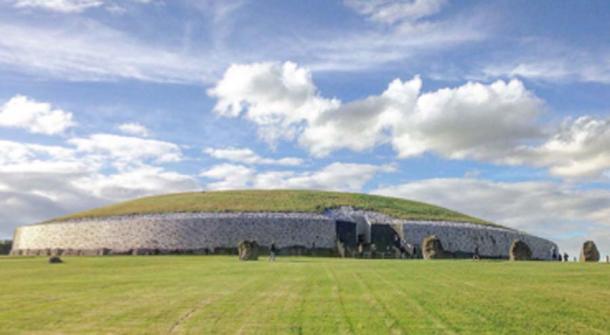
Survey Identifies Neolithic Monument Aligned With the Winter Solstice at Brú na Bóinne
The Newgrange Stone Age monument in Ireland is of great archaeological importance and it’s extent keep reaching new bounds. In recent years many historic remains have been identified in the area around this UNESCO World Heritage Site. A team of international experts have announced that 40 more historic sites have been discovered in this area dating from the Stone Age to the Middle Ages.
The new sites are located near the world famous Newgrange tomb complex in County Meath, which is 5,000 years old, even older than the Egyptian pyramids. This is a passage tomb and temple and is near two other important Stone Age burial sites at Knowth and Dowth. It was used in the Stone Age to celebrate the Winter Solstice, which is still celebrated at Newgrange to this day.

Interior of Knowth tomb, close to the discovery of the Neolithic monument. (Jeanhousen / CC BY-SA 3.0)
The finds were made in the Brú na Bóinne area near the Boyne River. According to the Irish Examiner, the area surveyed “included locations both sides of the Boyne, within the bend of the Boyne”.
40 Monuments Discovered
Over the summer approximately 40 previously unrecorded monuments have been identified, close to Newgrange, below the ground. These monuments range in date from the Neolithic to the medieval period. Dr. Steve Davies of the archaeology department of UCD stated that the oldest monuments “range from what are most likely Neolithic houses to Neolithic timber enclosures” according to the Irish Examiner.
There were also some large Bronze Age burial monuments identified that date from 2,000 - 500 BC. Some farms from the Dark Ages have also been found beneath the earth. The discovery of up to 40 monuments indicates that this part of Ireland was densely populated for millennia and this is not surprising as it is rich agricultural land.
The survey was a collaborative effort conducted by the “UCD School of Archaeology and the Romano-Germanic Commission in Frankfurt” reports the Irish Mirror. It is part of the research project ‘Boyne to Brodgar’.
This is investigating the Neolithic sites in the Boyne Valley and at Brodgar on the Orkney Islands, off the coast of Scotland. These are regarded as two of the most important Late Stone Age sites in Europe, if not the world. The project is funded by the German government.
- Newgrange: A Home for Magicians, Fairies, Gods, and Kings
- Newgrange and the Boyne Valley monuments – advanced lunar calculations and observation of the effects of precession of equinoxes in Neolithic Ireland - Part 2
- Shedding Light on Newgrange: 5,000-Year-Old Sun Trap May Not Be All That it Seems

The Ring of Brodgar is a Neolithic monument / henge and stone circle at Brodgar on the Orkney Islands. (Stevekeiretsu / CC BY-SA 3.0)
Satellites, Drones, and Geo-Imaging
The survey was carried out using “satellite-based remote sensing, drones, airborne laser scanning, and geophysics” reports RTE. It also used geophysical imaging machines to detect the monuments underground, this technology was originally designed to located unexploded bombs and landmines.
The Irish Examiner reports that “Professor Eszter Bánffy, director of the Romano-Germanic Commission, and her colleague Dr. Knut Rassmann, have provided the infrastructure” for the survey. This investigation of the Brú na Bóinne area began five years ago.
The technology allowed the team to survey up to 50 acres (20 hectares) per day. Many images were taken by a radar system that was provided by the German Aerospace Centre. This has allowed researchers to have a better understanding of the history of the Brú na Bóinne landscape.
Mysterious Monument Found
Dr. Davies also announced that a monument that was found, near Newgrange, in a previous survey in 2017, is of great historical importance. It is “a large, rectangular arrangement of wooden posts enclosing a timber or stone passage” according to the Irish Independent. This was in turn enclosed by a series of wooden stakes set in a series of circles.

A front view of the Newgrange Neolithic monument taken from outside the grounds. (Tjp finn / CC BY-SA 4.0)
Dr. Davies told the Irish Mirror that the new find is “a key monument that is the largest and most complicated of its type in the world”. It was built two to three centuries after Newgrange and it was constructed over many decades.
Based on the research, it appears that it also was aligned with the Winter Solstice like the Newgrange monument. This structure along with the older passage tomb / temple, probably formed part of a sacred or cultural landscape in the Neolithic period.
The survey will continue, and the team hopes to investigate the area to the south of the Boyne and expects more discoveries to be made. Professor Bánffy told RTE that “the first very, very preliminary results are exciting and there are features that need further investigation”.

UCD undertaking bathymetric and sonar surveys in Brú na Bóinne as part of a study aimed at improving the understanding of the Brú na Bóinne area. (UCD School of Archaeology / Facebook)
There are still some gaps in the researchers’ knowledge of the history of the area and how the various monuments were connected. When the survey is complete it will have surveyed an area 3.1 miles (5 kilometers) in size. Some of the monuments may in the future be excavated by archaeologists.
Top image: Archeologists have identified about 40 previously unknown monuments near Newgrange. The Boyne to Brodgar Project is examining connections between the Boyne Valley and the Orkney Islands. Source: Dr. Davis / UCD School of Archaeology.
By Ed Whelan















